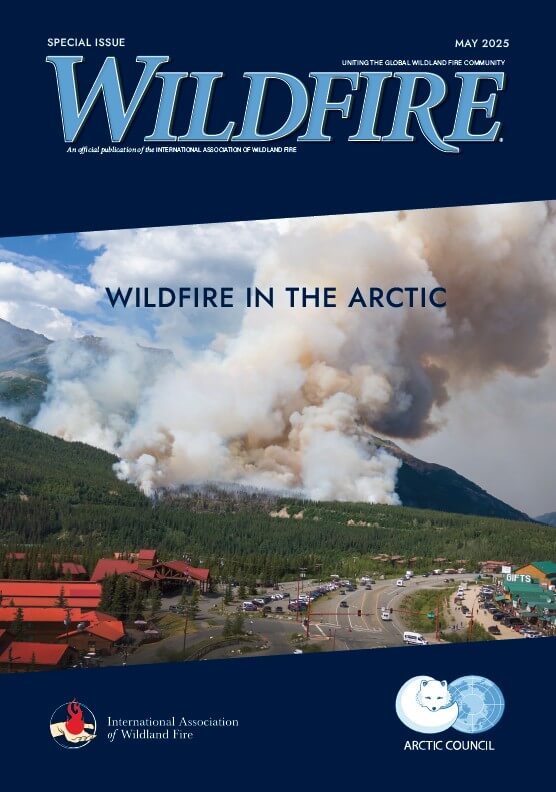President’s Desk: Widening the Lens on Aerial Fire Fighting
BY TREVOR HOWARD
This edition of Wildfire magazine covers the important, sometimes misunderstood, and often debated topic of aerial fire fighting. We have four articles by researchers from France, Canada, the United States, and Australia evaluating the effectiveness of aerial wildfire suppression. This work makes a significant contribution to our body of knowledge on aerial fire fighting and each of the studies has included some operational input, but there are many other viewpoints and perspectives on effectiveness in fire and aviation.
While the roles and titles differ across the globe, incident management teams normally set overall incident objectives, with the officer responsible for operations developing, implementing and adjusting strategies and tactics through divisions and sectors, intelligence from the field etc. A supervisor of aerial operations, in an aircraft above the incident, coordinates all other aircraft and also adjusts strategies and tactics according to conditions, the effectiveness of water, foam, and retardant drops, personal observations, and communication with a ground controller. So, there are various players in the operational chain of command, including pilots, who are experts in the effectiveness of aerial fire fighting and stakeholders in this discussion. We’d like to hear more from them in future issues of Wildfire.
It is also important to highlight the broader context of aerial fire fighting. While usually under contracts and operational control by government agencies, there are many unseen parts of aerial fire fighting. For a start, the private sector makes a massive investment in aircraft, infrastructure and technology as well as employment in a vast range of roles to deliver and maintain aircraft and services. The links between fire agencies and aviation companies are often quite different than other contracted operational services, such as earthmoving machinery. With aviators and their
support teams operating from airfields and hangars, pilots communicating with agency air attack supervisors above incidents, and other specialists dealing with seasonal preparedness, contractual matters and afteraction reviews, some opportunities to collaborate and learn from each other may not be realised. For example, wildland fire agencies have long been held up by researchers as high reliability organisations, performing consistently and safely in hazardous operating environments, while aviation companies have their own expertise, cultures, procedures and communications protocols to ensure reliability, risk and safety management, and resilience.
Another largely unseen aspect of aerial fire fighting also happens well away from firegrounds and the public. In Australia, fixed-wing aircraft, especially the smaller single engine air tankers, often work from rural airfields where the local community steps up to support operations. Many of the people with roles in reloading aircraft with water and additives for effectiveness, come from local volunteer fire brigades, emergency services units and the like. Sometimes low-risk prisoners from regional correctional services facilities are actively involved. Aerial fire fighting doesn’t just
protect rural communities, it involves them in ways that can be mutually beneficial and long-lasting.
Aerial fire fighting is not just about dropping suppressants on fires and retardants on vegetation. Surveillance and reconnaissance flights involving a broad range of aircraft types and technologies are essential for capturing the location, extent, intensity and potential impacts of fires and for translating that intelligence into a common operating picture and strategies for action. Suitably equipped aircraft can capture and share images and data during night-time operations and when smoke and cloud hinder other flights and visual assessments. These applications are not just for managing wildfires. Western Australia, for example, has one the largest science-based prescribed burning programs in the world, and for more than 50 years has used a fleet of small aircraft (currently the American Champion Scout) to monitor active prescribed burns as well as to detect wildfires. Multiple daily flights and circuits are planned and scheduled according to active burn and current wildfire locations, fire danger indices, areas of high risk (campgrounds, for example), and visibility from a network of fire towers across forested lands.
Taking an even broader view of aerial fire fighting, aerial ignition is an essential and well-proven approach to managing land and mitigating the effects and impacts of wildfires, as well as for backburning and burning out areas during wildfire suppression operations. Developed in Australia and pioneered operationally in the southwest forests in the mid-1960s, aerial ignition is now used around the world. Its usefulness and potential are yet to be fully realised in parts of the world that are experiencing major changes in climate and fire regimes, such as northern Europe.
In Australia today, beyond the management of fuels in forestry, parks and conservation, pastoralism, and rural fire management contexts, it is in the north of the country that the major users of aerial ignition are Indigenous organisations, burning for cultural, biodiversity and carbon outcomes. As drones and other technologies advance, lower cost, locally led programs and operations will be enabled. With IAWF members in 36 countries with different government agencies, resources, geographies, cultures, communities and land uses, this context and perspective on aerial fire fighting takes us beyond developed and developing nations.
 Trevor Howard is the national manager, prescribed burning strategy, with the Australasian Fire and Emergency Service Authorities Council (AFAC). Based at the Bushfire Centre of Excellence in Western Australia, Howard leads national capability development for prescribed burning and supports rural fire services, land management agencies and non-government organisations with continual improvement.
Trevor Howard is the national manager, prescribed burning strategy, with the Australasian Fire and Emergency Service Authorities Council (AFAC). Based at the Bushfire Centre of Excellence in Western Australia, Howard leads national capability development for prescribed burning and supports rural fire services, land management agencies and non-government organisations with continual improvement.
